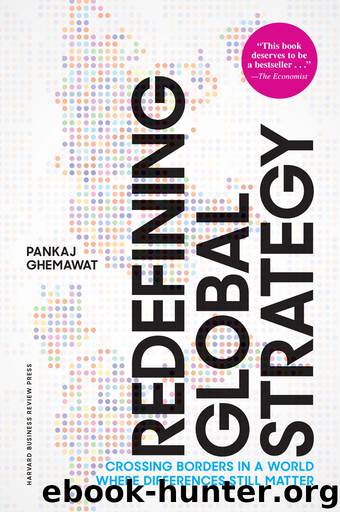Redefining Global Strategy: Crossing Borders in a World Where Differences Still Matter by Pankaj Ghemawat

Author:Pankaj Ghemawat
Language: eng
Format: epub
Publisher: Harvard Business Review Press
Published: 2016-05-26T04:00:00+00:00
Transformation
Transformation is a way in which firms may directly try to reduce the need for adaptation—by seeking to shape or transform the local environments in which they operate—instead of trying, as just discussed, to enhance their abilities to fit in. McDonald’s, by developing markets around the systems that it had built up rather than the reverse, is often credited with being one of the first successful practitioners of this strategy on a global scale. Starbucks provides another interesting example. Although the Seattle-based coffee giant is frequently cited as being in the vanguard of American cultural imperialism, this accusation is a little misguided. Writing in his autobiography, CEO Howard Schultz paints a fascinating picture of his original attempt to recreate an Italian-espresso-bar experience in the United States—right down to recorded opera music and bow-tied waiters.39 Although the opera music and bow ties soon disappeared—in a form of adaptation—Schultz had successfully called forth a clientele for a coffee-drinking experience that was substantially different from that of, say, Dunkin’ Donuts. He had transformed U.S. coffee drinkers, who now expected easy chairs, hip music, and a smoke-free environment to enhance their coffee-drinking experience.
The transformation experience was even more dramatic when Starbucks moved to Japan. The company insisted on exporting the smoking ban that had helped distinguish its American outlets. Skeptics said that this would certainly doom the chain in Japan by alienating the hordes of chain-smoking Japanese businessmen who traditionally crowded Japanese coffee parlors, or kissaten. Instead, the no-smoking policy helped Starbucks Japan, by enticing a female clientele who didn’t frequent the kissaten.
It bears repeating: because Starbucks was able to change local markets even while it was adapting to local conditions, it minimized the extent to which it ultimately had to adapt. Watch out, however, for a tendency to avoid other forms of adaptation by pretending that all situations can easily be transformed. Thus Microsoft, after a decade of making losses in China—where, the company now admits, it might wait another decade or two to make money—has given up on transformation. As one journalist put it, “It’s clear that Microsoft is no longer trying to change China; China is changing Microsoft.”40
Analyzing Adaptation
Many of the examples discussed in this chapter, particularly that of major home appliances, may have suggested that the principal objective of adaptation is to improve the demand curve that a company faces, that is, to enhance volume, willingness-to-pay, or both. But to think broadly about adaptation, it is important to remember the other components of the ADDING Value scorecard as well: influencing one or more of them may be an important objective, perhaps even the overriding one.
Some of the product indigenization efforts discussed in the subsection on localization provide examples of adaptation aimed at reducing costs. On the process side, the Boston Consulting Group (BCG) has recently stressed that an interesting way of adapting manufacturing to an emerging market context is by building disposable factories, defined as labor-intensive, dedicated factories designed for temporary mass production.41 Such factories can supposedly be built for as little as 20–30 percent of the cost of a U.
Download
This site does not store any files on its server. We only index and link to content provided by other sites. Please contact the content providers to delete copyright contents if any and email us, we'll remove relevant links or contents immediately.
Bad Blood by John Carreyrou(6283)
Rich Dad Poor Dad by Robert T. Kiyosaki(6185)
Principles: Life and Work by Ray Dalio(5980)
Playing to Win_ How Strategy Really Works by A.G. Lafley & Roger L. Martin(5524)
Management Strategies for the Cloud Revolution: How Cloud Computing Is Transforming Business and Why You Can't Afford to Be Left Behind by Charles Babcock(4440)
The Confidence Code by Katty Kay(4041)
Thinking in Bets by Annie Duke(4007)
American Kingpin by Nick Bilton(3510)
Delivering Happiness by Tony Hsieh(3284)
Project Animal Farm: An Accidental Journey into the Secret World of Farming and the Truth About Our Food by Sonia Faruqi(3019)
The Power of Habit by Charles Duhigg(2970)
Brotopia by Emily Chang(2899)
Mastering Bitcoin: Programming the Open Blockchain by Andreas M. Antonopoulos(2895)
The Tyranny of Metrics by Jerry Z. Muller(2853)
I Live in the Future & Here's How It Works by Nick Bilton(2847)
The Marketing Plan Handbook: Develop Big-Picture Marketing Plans for Pennies on the Dollar by Robert W. Bly(2801)
The Content Trap by Bharat Anand(2781)
Building a StoryBrand by Donald Miller(2759)
Applied Empathy by Michael Ventura(2754)
